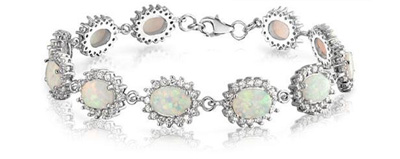

Fireworks. Jellyfish. Galaxies. Lightning. Opal's shifting play of kaleidoscopic colors is unlike any other gem.
Opal's microscopic arrays of stacked silica spheres diffract light into a blaze of flashing colors. An opal's color range and pattern help determine its value.
Because opal has the colors of other gems, the Romans thought it was the most precious and powerful of all. The Bedouins believed that opals contained lightning and fell from the sky during thunderstorms. When Australia's mines began to produce opals commercially in the 1890s, it quickly became the world's primary source for this October birthstone.



Grids of silica spheres 0.2 microns in size create red play-of-color flashes.
The novel “Anne of Geierstein” gave opal a reputation of being unlucky.
The novel “Anne of Geierstein” gave opal a reputation of being unlucky.
Play-of-color, intensity, and pattern are important value factors.

Opal's spectacular play-of-color can display all the colors of the rainbow.

Experts expect different levels of clarity for different types of opals.

Fine opals are often cut into irregular shapes that keep as much play-of-color as possible.

Opal has relatively low density so even larger sizes can be comfortable to wear.
Use this space to save the products you like. To add a product here, simply click the icon.